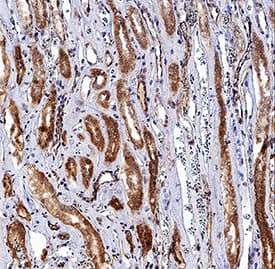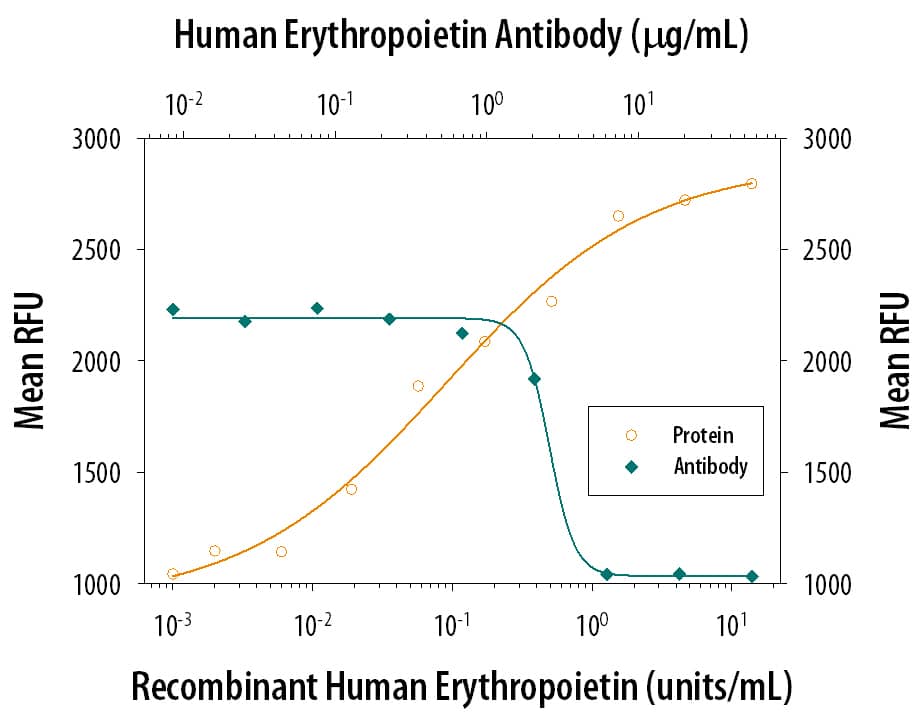Human Erythropoietin/EPO Antibody
R&D Systems, part of Bio-Techne | Catalog # AB-286-NA

Key Product Details
Species Reactivity
Validated:
Human
Cited:
Human, Hamster - Cricetulus (Chinese Hamster)
Applications
Validated:
Immunohistochemistry, Neutralization, Western Blot
Cited:
ELISA Detection, Immunocytochemistry, Western Blot
Label
Unconjugated
Antibody Source
Polyclonal Rabbit IgG
Product Specifications
Immunogen
Chinese hamster ovary cell line (CHO)-derived recombinant human Erythropoietin/EPO
Specificity
Detects human Erythropoietin/EPO in direct ELISAs and Western blots.
Clonality
Polyclonal
Host
Rabbit
Isotype
IgG
Endotoxin Level
<0.10 EU per 1 μg of the antibody by the LAL method.
Scientific Data Images for Human Erythropoietin/EPO Antibody
Cell Proliferation Induced by Erythropoietin/EPO and Neutralization by Human Erythropoietin/EPO Antibody.
Recombinant Human Erythropoietin/EPO (Tissue Culture Grade) (Catalog # 287-TC) stimulates proliferation in the TF-1 human erythroleukemic cell line in a dose-dependent manner (orange line) as measured by Resazurin (Catalog # AR002). Proliferation elicited by Recombinant Human Erythropoietin/EPO (Tissue Culture Grade) (0.2 units/mL) is neutralized (green line) by increasing concentrations of Rabbit Anti-Human Erythropoietin/EPO Polyclonal Antibody (Catalog # AB-286-NA). The ND50 is typically <3 µg/mL.Erythropoietin/EPO in Human Kidney.
Erythropoietin/EPO was detected in immersion fixed paraffin-embedded sections of human kidney using Rabbit Anti-Human Erythropoietin/EPO Polyclonal Antibody (Catalog # AB-286-NA) at 15 µg/mL for 1 hour at room temperature followed by incubation with the Anti-Rabbit IgG VisUCyte™ HRP Polymer Antibody (Catalog # VC003). Tissue was stained using DAB (brown) and counterstained with hematoxylin (blue). Specific staining was localized to convoluted tubules. View our protocol for IHC Staining with VisUCyte HRP Polymer Detection Reagents.Applications for Human Erythropoietin/EPO Antibody
Application
Recommended Usage
Immunohistochemistry
5-15 µg/mL
Sample: Immersion fixed paraffin-embedded sections of human kidney
Sample: Immersion fixed paraffin-embedded sections of human kidney
Western Blot
1 µg/mL
Sample: Recombinant Human Erythropoietin/EPO (Ultrapure) (Catalog # 286-EP)
Sample: Recombinant Human Erythropoietin/EPO (Ultrapure) (Catalog # 286-EP)
Neutralization
Measured by its ability to neutralize Erythropoietin/EPO-induced proliferation in the TF‑1 human erythroleukemic cell line. Kitamura, T. et al. (1989) J. Cell Physiol. 140:323. The Neutralization Dose (ND50) is typically <3 µg/mL in the presence of 0.2 units/mL Recombinant Human Erythropoietin/EPO (Tissue Culture Grade).
Reviewed Applications
Read 1 review rated 4 using AB-286-NA in the following applications:
Formulation, Preparation, and Storage
Purification
Protein A or G purified
Reconstitution
Reconstitute at 1 mg/mL in sterile PBS.
Formulation
Lyophilized from a 0.2 μm filtered solution in PBS with Trehalose.
Shipping
The product is shipped at ambient temperature. Upon receipt, store it immediately at the temperature recommended below.
Stability & Storage
Use a manual defrost freezer and avoid repeated freeze-thaw cycles.
- 12 months from date of receipt, -20 to -70 °C as supplied.
- 1 month, 2 to 8 °C under sterile conditions after reconstitution.
- 6 months, -20 to -70 °C under sterile conditions after reconstitution.
Background: Erythropoietin/EPO
Alternate Names
ECYT5, EPO, MVCD2
Gene Symbol
EPO
Additional Erythropoietin/EPO Products
Product Documents for Human Erythropoietin/EPO Antibody
Product Specific Notices for Human Erythropoietin/EPO Antibody
For research use only
